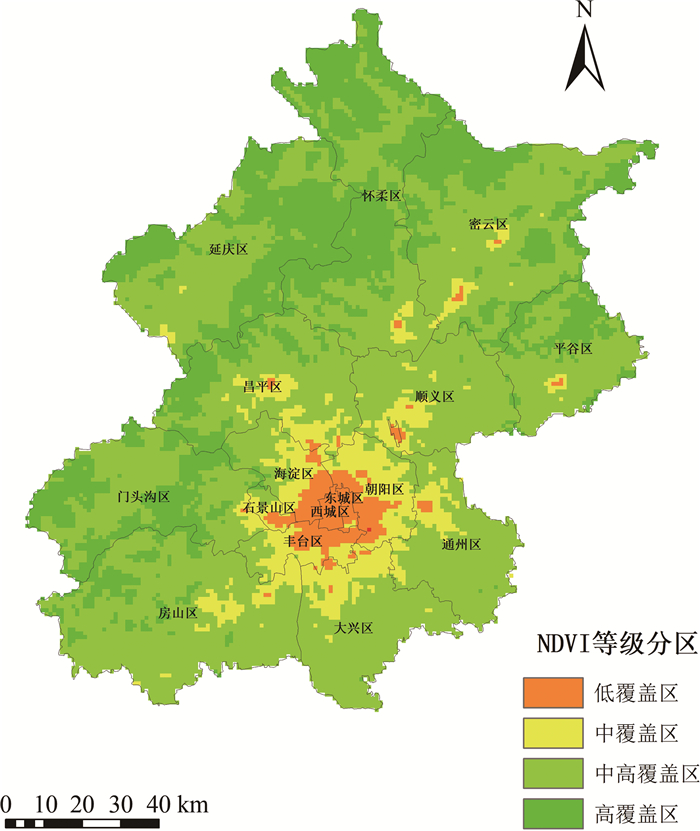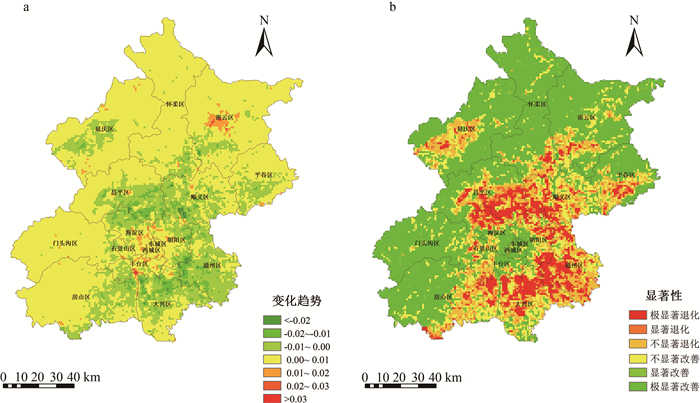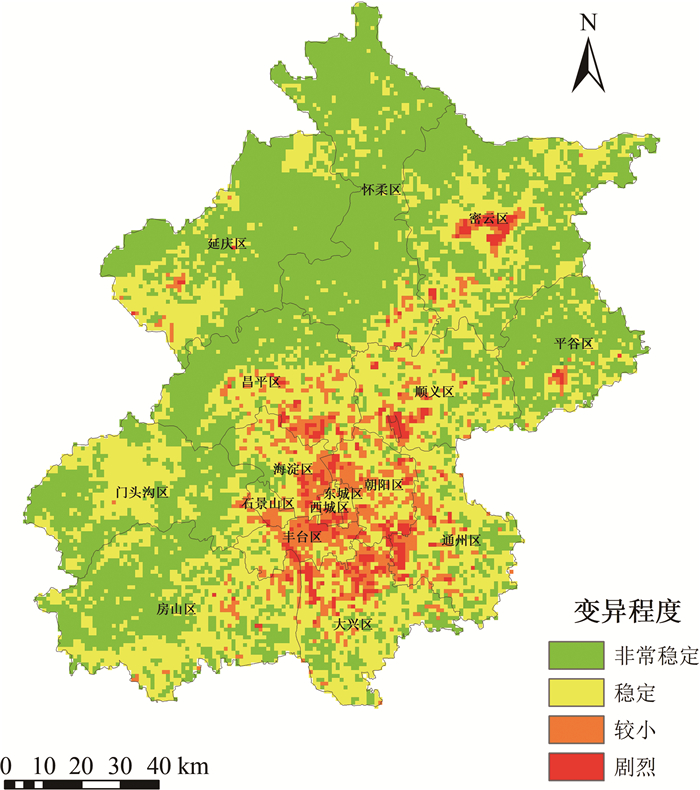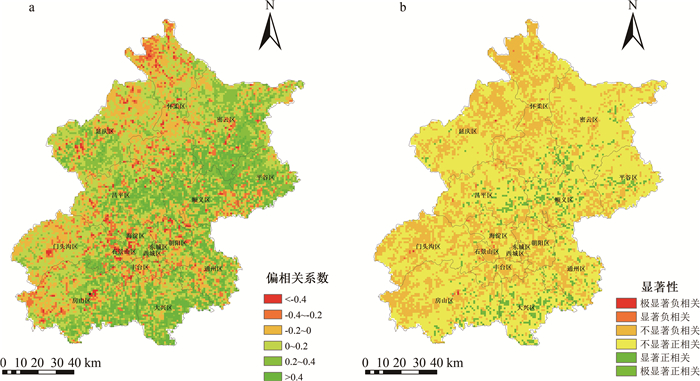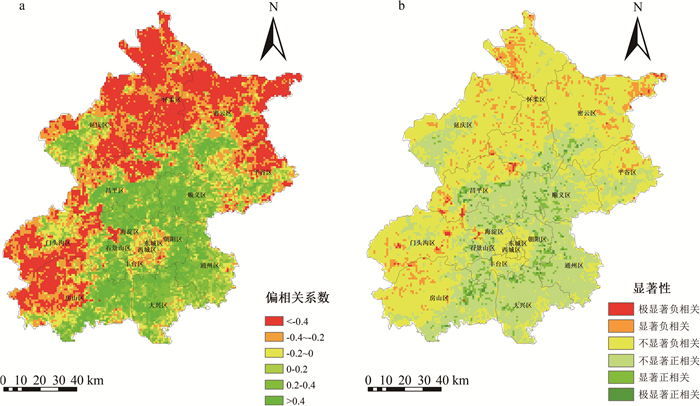Correlation between temporal-spatial changes of vegetation and climate factors in Beijing
-
摘要:
基于北京市2000—2015年SPOT遥感影像归一化植被指数(NDVI),结合气温、降水量、日照时长等气候因子,采用一元线性回归分析法、趋势分析法、变异系数法及二阶偏相关系数法,剖析北京NDVI时空变化与气候因子的相关性:2000—2015年间,北京植被覆盖变化总体呈缓慢波动上升趋势;中心城区多为低植被覆盖区,郊区多为高植被覆盖区;NDVI呈上升趋势的面积占总面积的73.09%,植被覆盖水平有所提升;多数区域NDVI波动较小,波动剧烈区域主要集中于东城区和西城区;由偏相关系数及其显著性可知,降水量对NDVI影响最大,气温次之,日照时长影响居后。
Abstract:Based on the normalized vegetation index (NDVI) data of SPOT remote sensing images in Beijing from 2000 to 2015, combined with the data of climate factors such as temperature, precipitation and sunshine duration, univariate linear regression analysis, trend analysis, coefficient of variation and second-order partial correlation coefficient were used to analyze the correlation between temporal-spatial changes of NDVI and climate factors in Beijing.The change of vegetation cover in Beijing in the past 16 years showed a slow fluctuation and upward trend.The low vegetation coverage area was mainly distributed in the central urban area, and the high vegetation coverage area was mainly distributed in the outer suburbs.The area with increasing NDVI accounted for 73.09% of the total area, and the vegetation coverage level was improved.In most areas, the fluctuation of NDVI was small, and the areas with severe fluctuation were mainly concentrated in Dongcheng District and Xicheng District.According to the partial correlation coefficient and its significance, it is concluded that precipitation had the greatest impact on NDVI, followed by temperature and sunshine duration.
-
Key words:
- remote sensing data /
- NDVI /
- temporal and spatial change /
- climate factors /
- correlation analysis /
- Beijing
-

-
表 1 2000—2015北京市NDVI变化趋势显著性
Table 1. Statistics of significance of NDVI change trend in Beijing from 2000 to 2015
类型 极显著退化 显著退化 不显著退化 不显著改善 显著改善 极显著改善 占比/% 8.76 4.09 14.07 15.03 6.35 51.72 表 2 各气候因子与NDVI值二阶偏相关系数及其显著性
Table 2. Statistics of second-order partial correlation coefficient and significance between climate factors and NDVI value
气候因子 二阶偏相关系数均值 二阶偏相关系数范围 正相关占比/% 显著正相关占比/% 极显著正相关占比/% 负相关占比/% 显著负相关占比/% 极显著负相关占比/% 气温 0.1171 -0.76~ 0.86 68.30 4.81 1.32 31.70 0.26 0.00 降水量 0.2742 -0.54~ 0.83 87.11 10.25 1.22 12.89 0.00 0.00 日照时长 -0.0985 -0.79~ 0.88 38.80 3.99 0.57 61.20 6.56 0.46 -
[1] 李晓兵, 陈云浩, 张云霞, 等. 气候变化对中国北方荒漠草原植被的影响[J]. 地球科学进展, 2002, (2): 254-261. doi: 10.3321/j.issn:1001-8166.2002.02.015
[2] 宋鹏飞, 季民, 李刚. 山东省近10年植被覆盖度变化与气候因子相关性分析[J]. 测绘通报, 2018, (12): 109-113. https://www.cnki.com.cn/Article/CJFDTOTAL-CHTB201812024.htm
[3] 魏吉鑫, 刘斯文, 李海潘, 等. 江西赣州废弃离子型稀土矿修复区植被高光谱特征与健康状况评价[J]. 地质通报, 2020, 39(12): 2037-2043. http://dzhtb.cgs.cn/gbc/ch/reader/view_abstract.aspx?file_no=20201217&flag=1
[4] Huete A. Overview of the radiometric and biophysical performance of the MODIS vegetation indices[J]. Remote Sensing of Environment, 2002, 83(1): 195-213. http://www.onacademic.com/detail/journal_1000034154620510_4d7d.html
[5] 刘恒, 汤弟伟, 孙毅, 等. 武陵山区植被生长季NDVI时空变化及其对气候变化的响应[J]. 水土保持研究, 2021, 28(5): 245-253. https://www.cnki.com.cn/Article/CJFDTOTAL-STBY202105035.htm
[6] Zhu L J, Ming J J, Zhu L K. Applying Geodetector to disentangle the contributions of natural and anthropogenic factors to NDVI variations in the middle reaches of the Heihe River Basin[J]. Ecological Indicators, 2020, 117: 106545. doi: 10.1016/j.ecolind.2020.106545
[7] 金凯, 王飞, 韩剑桥, 等. 1982-2015年中国气候变化和人类活动对植被NDVI变化的影响[J]. 地理学报, 2020, 75(5): 961-974. https://www.cnki.com.cn/Article/CJFDTOTAL-DLXB202005007.htm
[8] 张清雨, 赵东升, 吴绍洪, 等. 基于生态分区的内蒙古地区植被覆盖变化及其影响因素研究[J]. 地理科学, 2013, 33(5): 594-601. https://www.cnki.com.cn/Article/CJFDTOTAL-DLKX201305013.htm
[9] 党跃军, 王礼霄, 严俊霞. 山西省2003-2012年植被时空变化格局及对气候因子的响应[J]. 水土保持研究, 2015, 22(2): 235-240. https://www.cnki.com.cn/Article/CJFDTOTAL-STBY201502044.htm
[10] 谢胜金, 刘永和, 姚风欣. 1998-2015年北京市NDVI时空变化及其与气候因子的响应关系[J]. 水土保持研究, 2020, 27(3): 190-196. https://www.cnki.com.cn/Article/CJFDTOTAL-STBY202003028.htm
[11] 王华, 杨乾鹏, 郭山川, 等. Landsat时序数据支持下的藏东南植被时空变化监测[J]. 测绘通报, 2020, (11): 7-12. https://www.cnki.com.cn/Article/CJFDTOTAL-CHTB202011002.htm
[12] 崔珍珍, 马超, 陈登魁. 1982-2015年科尔沁沙地植被时空变化及气候响应[J]. 干旱区研究, 2021, 38(2): 536-544. https://www.cnki.com.cn/Article/CJFDTOTAL-GHQJ202102025.htm
[13] 侯美亭, 胡伟, 乔海龙, 等. 偏最小二乘(PLS)回归方法在中国东部植被变化归因研究中的应用[J]. 自然资源学报, 2015, 30(3): 409-422. https://www.cnki.com.cn/Article/CJFDTOTAL-ZRZX201503005.htm
[14] 张凯选, 范鹏鹏, 王军邦, 等. 西南喀斯特地区植被变化及其与气候因子关系研究[J]. 生态环境学报, 2019, 28(6): 1080-1091. https://www.cnki.com.cn/Article/CJFDTOTAL-TRYJ201906002.htm
[15] 许玉凤, 潘网生, 张永雷. 贵州高原NDVI变化及其对气候变化的响应[J]. 生态环境学报, 2020, 29(8): 1507-1518. https://www.cnki.com.cn/Article/CJFDTOTAL-TRYJ202008002.htm
[16] 徐建华. 现代地理学中的数学方法[M]. 北京: 高等教育出版社, 2017.
[17] 杜灵通, 徐友宁, 宫菲, 等. 宁东煤炭基地植被生态特征及矿业开发对其的影响[J]. 地质通报, 2018, 37(12): 2215-2223. http://dzhtb.cgs.cn/gbc/ch/reader/view_abstract.aspx?file_no=20181212&flag=1
[18] 覃巧婷, 陈建军, 杨艳萍, 等. 黄河源植被时空变化及其对地形和气候的响应[J]. 中国环境科学, 2021, 41(8): 3832-3841. doi: 10.3969/j.issn.1000-6923.2021.08.041
[19] 刘宪锋, 潘耀忠, 朱秀芳, 等. 2000-2014年秦巴山区植被覆盖时空变化特征及其归因[J]. 地理学报, 2015, 70(5): 705-716. https://www.cnki.com.cn/Article/CJFDTOTAL-ZGDE201601004.htm
[20] 王永财, 孙艳玲, 王中良. 1998-2011年海河流域植被覆盖变化及气候因子驱动分析[J]. 资源科学, 2014, 36(3): 594-602. https://www.cnki.com.cn/Article/CJFDTOTAL-ZRZY201403019.htm
[21] 李双双, 张玉凤, 汪成博, 等. 气候变化和生态建设对秦岭-淮河南北植被动态的影响[J]. 地理科学进展, 2021, 40(6): 1026-1036. https://www.cnki.com.cn/Article/CJFDTOTAL-DLKJ202106012.htm
[22] 孙晓鹏, 王天明, 邬建国, 等. 北京市2008年奥运前后植被覆盖变化趋势[J]. 应用生态学报, 2012, 23(11): 3133-3140. https://www.cnki.com.cn/Article/CJFDTOTAL-YYSB201211032.htm
[23] 刘涛, 曹广忠. 北京市制造业分布的圈层结构演变——基于第一、二次基本单位普查资料的分析[J]. 地理研究, 2010, 29(4): 716-726. https://www.cnki.com.cn/Article/CJFDTOTAL-DLYJ201004014.htm
[24] 廖春贵, 胡宝清, 熊小菊, 等. 广西植被时空变化及其对气候响应[J]. 森林与环境学报, 2018, 38(2): 178-184. https://www.cnki.com.cn/Article/CJFDTOTAL-FJLB201802008.htm
-



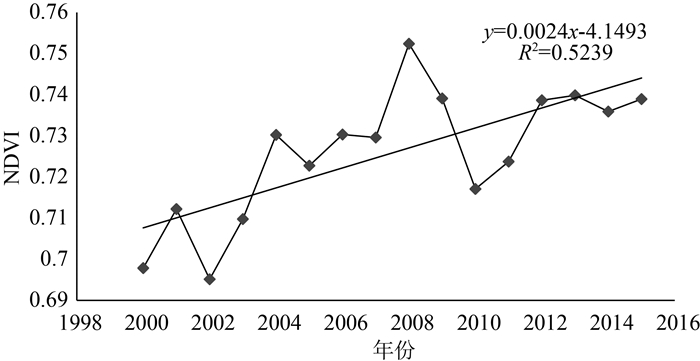
 下载:
下载:
